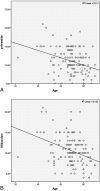Percutaneous balloon kyphoplasty with the patient under intravenous analgesia and sedation: a feasibility study
- PMID: 21273350
- PMCID: PMC7965882
- DOI: 10.3174/ajnr.A2345
Percutaneous balloon kyphoplasty with the patient under intravenous analgesia and sedation: a feasibility study
Abstract
Background and purpose: Kyphoplasty is a minimally invasive procedure for the treatment of malignant or osteoporotic vertebral compression fractures, normally performed with the patient under general anesthesia. This may cause a therapeutic dilemma because these patients often have a very high risk for general anesthesia due to concomitant diseases. The aim of this study was to evaluate the safety and feasibility of percutaneous kyphoplasty by using IV anesthesia and sedation with midazolam and piritramide.
Materials and methods: From June 2007 to June 2009, we prospectively included 133 patients (77 women, 56 men; mean age, 69.18 ± 11.45 years) who were referred for BKP. Kyphoplasty was always performed under fluoroscopic guidance with a biplane angiographic system by using a transpedicular or extrapedicular approach. The individual anesthesia risk was assessed by using the ASA criteria. All procedures were performed with the patient under IV anesthesia and sedation with fractionated administration of midazolam and piritramide. Pain was assessed before and after treatment by using a VAS.
Results: Ninety-nine patients (74.4%) had a significantly increased risk for general anesthesia (ASA score, ≥ 3). A total of 162 kyphoplasty procedures were performed. The mean amounts of midazolam and piritramide used were 11.3 ± 4.38 mg and 11.8 ± 3.98 mg, respectively. No complications related to IV anesthesia and sedation occurred. Periprocedural pain management was rated as sufficient, and all patients would undergo the procedure again.
Conclusions: Percutaneous BKP with the patient under IV anesthesia and sedation with midazolam and piritramide is a safe and feasible method for treating vertebral compression fractures in patients with an increased risk for general anesthesia.
Figures

References
-
- Garfin SR, Yuan HA, Reiley MA. New technologies in spine: kyphoplasty and vertebroplasty for the treatment of painful osteoporotic compression fractures. Spine (Phila Pa 1976) 2001;26:1511–15 - PubMed
-
- Hierholzer J, Depriester C, Fuchs H, et al. . Percutaneous vertebroplasty [in German]. Rofo 2002;174:328–34 - PubMed
-
- Jensen ME, McGraw JK, Cardella JF, et al. . Position statement on percutaneous vertebral augmentation: a consensus statement developed by the American Society of Interventional and Therapeutic Neuroradiology, Society of Interventional Radiology, American Association of Neurological Surgeons/Congress of Neurological Surgeons, and American Society of Spine Radiology. AJNR Am J Neuroradiol 2007;28:1439–43 - PMC - PubMed
Publication types
MeSH terms
Substances
LinkOut - more resources
Full Text Sources
Medical
